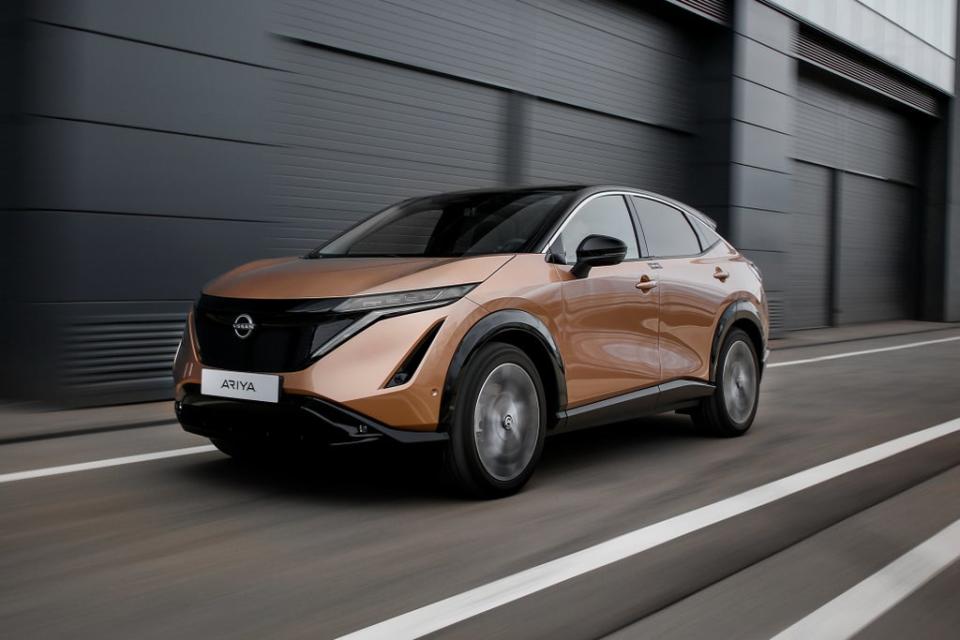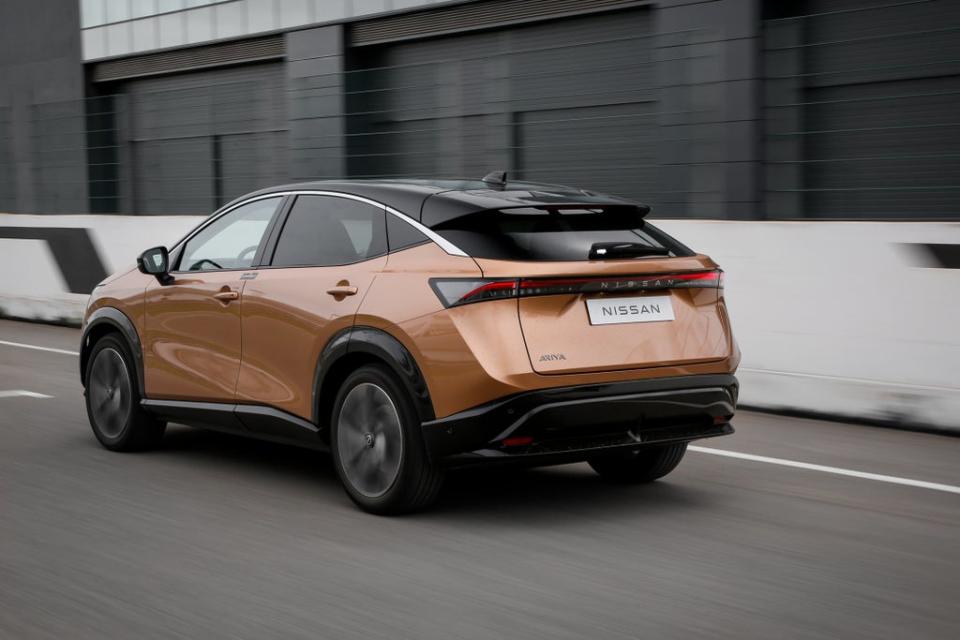Nissan’s new generation as car-maker goes fully electric by 2030

Nissan’s electrification plans continue apace, with the promise of 23 new EVs by the time the brand goes fully electric in 2030.
As a taster of future models, the company assembled prototypes of various new vehicles which will appear later this year for European journalists to try at the Jarama racing circuit near Madrid.
The new models include the Ariya, which Nissan calls the ultimate coupe crossover. This has strikingly good styling, which includes many of Nissan’s familiar motifs, such as the wide V-shaped “grille”, which, this being an EV, isn’t really a grille.
Confident
Designed in Paddington, the clean surfaces and simple lines give it a confident look and make it, to my eye, the best-looking road-going Nissan so far. With its super-long daytime running lights it looks a bit Qashqai-like, but its lines are stronger and it looks more sure of itself.
The cabin of my test car featured contrasting-coloured Alcantara panels on the door cards and integrated haptic touch buttons on the minimalist and neat dashboard. Two 12.3-inch adaptable screens and a head-up display give the roomy cabin a premium feel.
There is a huge range of driver assistance tech, including ProPilot, blind spot assist, adaptive driving beam, emergency lane-keeping, Intelligent route planner, Amazon Alexa voice control, live traffic updates and over-the-air updates.
There is a choice of 63 or 87kW batteries. I tried the smaller one, which can be charged to 99 per cent in two hours 45 minutes and has a range of up to 360 km. The 87kW version should have a range of up to 500km.
Pitching
The eventual range-topper will have the 87kW battery plus Nissan’s e-4ORCE technology, which includes two electric motors which control torque to each wheel and help reduce pitching during hard acceleration or deceleration.

A test mule in which the e-4ORCE system can be switched on and off clearly showed improved comfort for the car’s occupants when the pitch was reduced.
On the track the Ariya proved a gutsy performer, with good body control, thanks to a low centre of gravity and perfect 50-50 weight distribution. It isn’t a sports car, but for a highly refined and quiet family car it acquitted itself well. Prices will start at £41,845 when it appears later this year.
The Ariya will be Nissan’s second EV and it has been a long time coming. It is 12 years since the Leaf first appeared, and the new models benefit from all the accumulated customer feedback since then.
Another new one is the Juke Hybrid, which has 25 per cent more power than the internal combustion engine (ICE) version but its 1.6-litre engine uses 20 per cent less petrol and will be available with two or four-wheel-drive.
Signature
Being a hybrid there is no need to recharge. It has one-pedal technology, which slows the car effectively just by taking your foot off the throttle. Driven carefully you need only apply the brakes in an emergency.
The model uses Nissan’s “electrified vehicle signature sound” called Canto – Latin for “I sing”. In other words, a recognizable sound tone to mark the car out to pedestrians as a Nissan without them even seeing it. The hybrid has a new black mesh grille with black trim above, reshaped wheel arches for better aerodynamics and 19 or 20-inch wheels.
The hybrid gubbins steal a little of the bootspace, down to 354 litres from 422 in the ICE car, but 0-62mph acceleration in the hybrid is better at 10.1 seconds, as opposed to 11.8 in the ICE version.
Another model appearing later this year is the Qashqai e-Power. This has a 1.5-litre variable compression ratio petrol engine producing 116kW (190PS), which can change between more or less powerful outputs, depending on conditions. For example, high power for climbing a hill, lower power for urban driving.
Smooth
Power to the two-wheel-drive system is always electric, but using power generated by the petrol engine. This gives it 330 Nm of torque and enables one-pedal driving,
On the road it felt smooth and quiet in urban use and the cabin felt well made and attractive with soft-touch contrasting materials on the dashboard and piano black detailing.
The engine note varies with the amount of power demanded and the Qashqai provided gutsy performance on the track, with little body roll and smooth brakes.
The well finished cabin looks and feels well screwed together and the car was engaging to drive, roomy and comfortable.
Light commercial vehicles are also going electric and Nissan unveiled its new Townstar van, which will be in showrooms this summer. It has a 45kW battery which gives it a range of up to 300km and using an 80kW CCS charger it can charge from 15 to 80 per cent in 30 minutes.
With a car-like cabin, hands-free parking and 360-degree camera it should prove an easy-going work companion.

